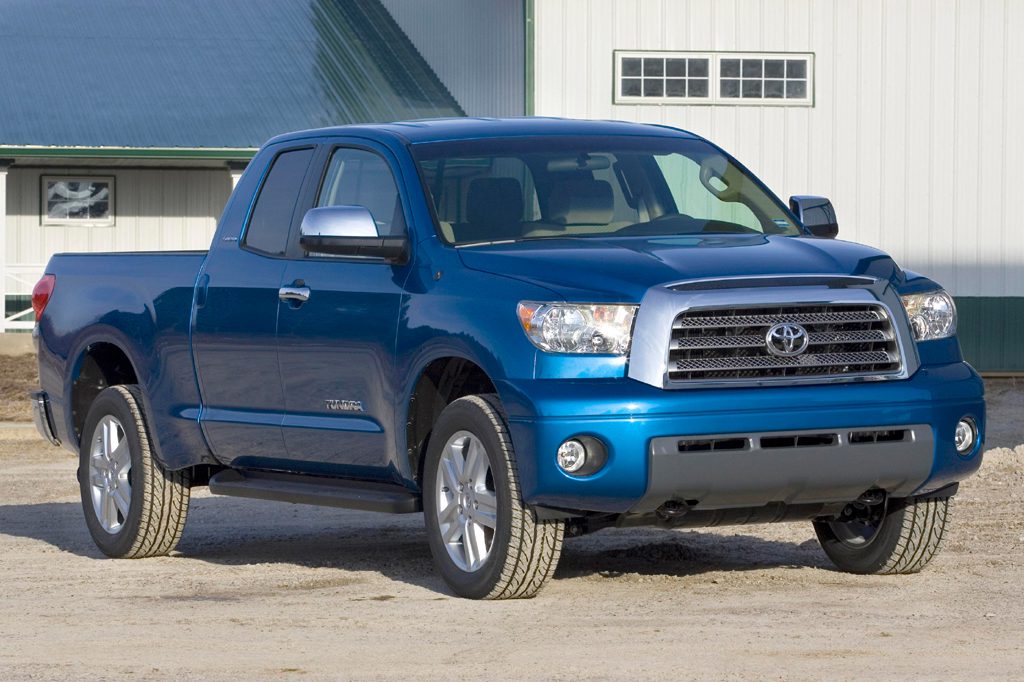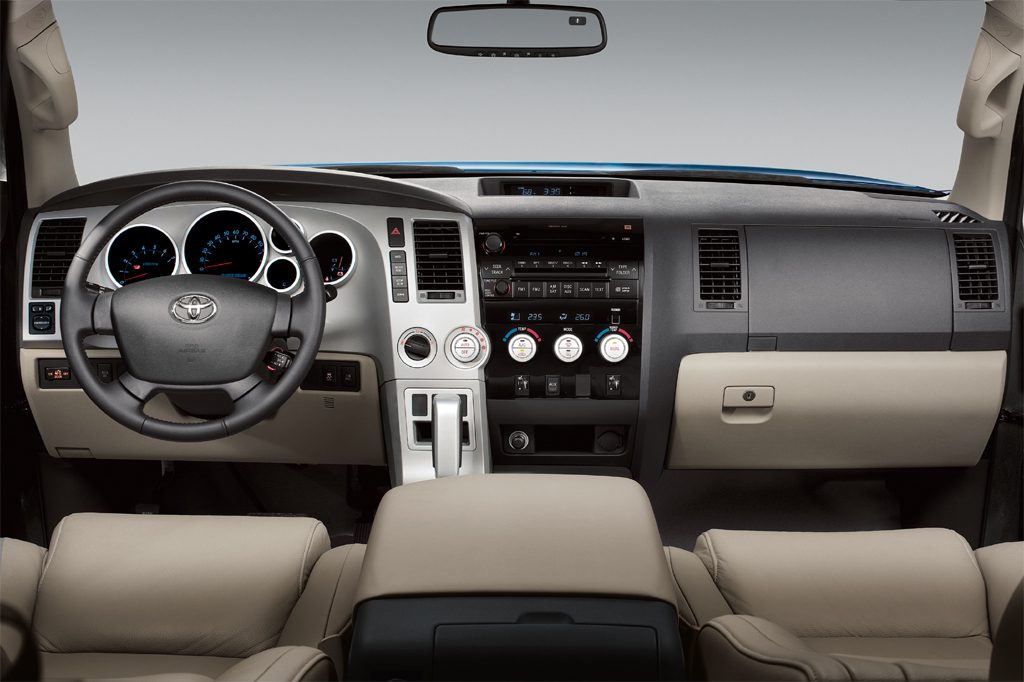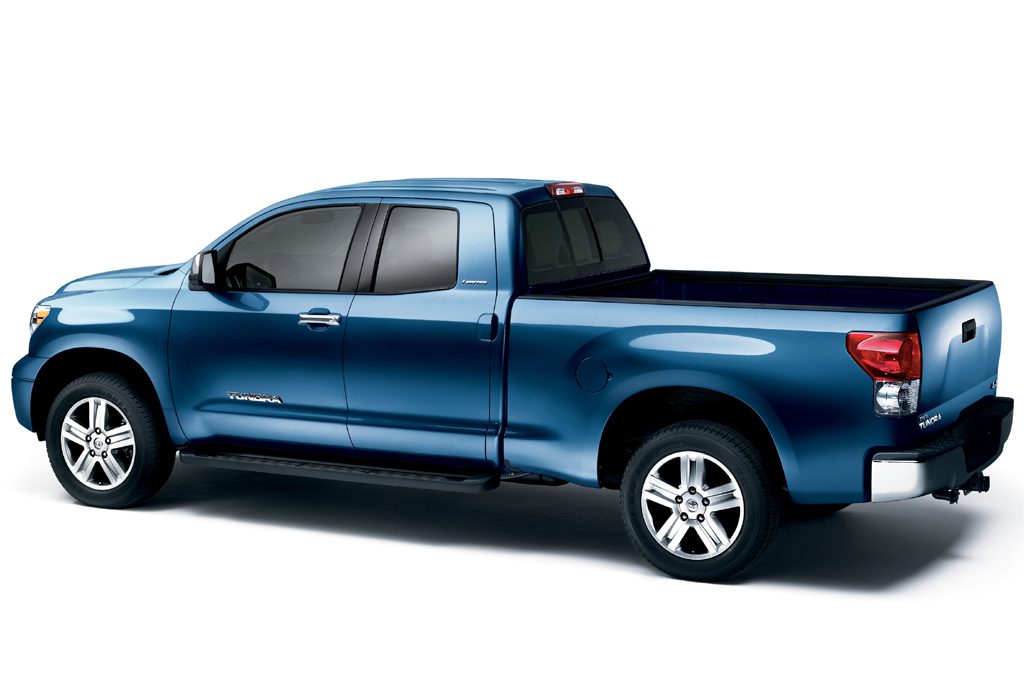| Large pickup truck; Built in USA |
|
|
| Good condition price range: $5,400 – $38,700* |

2008 Toyota Tundra

2008 Toyota Tundra

2008 Toyota Tundra

2008 Toyota Tundra
| Pros: |
|
| Cons: |
|
Toyota said the launch of the redesigned 2007 Tundra was the most important in the company’s 50-year U.S. history, intended to double the truck’s annual sales. Competing seriously against the domestic brands meant expanding Tundra’s appeal beyond the personal-use buyer, to those who need a real pickup for real work. This Tundra has the size, power, and model range to interest that crowd, but not the knockout punch to compel large numbers of GM, Ford, or Dodge loyalists to switch brands. Tundra trails GM and Ford for handling, interior materials, and overall refinement, but beats them in power and passenger accommodations.
Overview
Toyota’s larger pickup was redesigned for release during the 2007 model year, expanded in every dimension over the 2000-2006 models. Tundras equaled or exceeded comparable 2007 domestic-brand pickups in wheelbase and overall length. Among all pickups, only the 403-horsepower V8 in the Cadillac Escalade EXT topped Tundra’s available 381-hp V8 in 2007. However, in later years other trucks also grew and added more powerful engines.
Built in Texas and in Indiana, Tundra came in three cab styles, three wheelbases, and three bed lengths, with any of three engines and in three trim levels. Two-door, three-passenger regular cabs came in price-leader DX and dressier SR5 trim. Both the Double Cab and longer CrewMax crew cab had four conventional doors, seated six, and came in SR5 and top-line Limited trim.
Retained from the prior Tundra was a 236-hp V6, standard in regular and Double cabs. Also retained was a 271-hp, 4.7-liter V8, which was optional for those models but standard in CrewMax trucks. Optional on all was the 381-hp, 5.7-liter V8. That one used a six-speed automatic transmission, versus a five-speed automatic with other engines. Both automatics had manual-shift capability. Tundras were available with four-wheel drive that should not be left engaged on dry pavement, but included low-range gearing. Cargo-bed lengths were 6.5 feet on regular and Double Cab short-beds, 8.1 feet on Double Cab long-beds, and 5.5 feet on CrewMax pickups.
All Tundras had antilock all-disc brakes and traction/antiskid control. Also standard were front side airbags and curtain side airbags that covered both seating rows and included rollover deployment. Limited versions featured leather upholstery and were available with 20-inch wheels, versus Tundra’s standard 18s. CrewMax models had a power rear-cab window and were available with DVD entertainment. Among Tundra’s options were an off-road package, and a navigation system that included a rearview camera positioned to show the trailer hitch. Domestic-brand rivals included the Chevrolet Silverado 1500, Ford F-150, or GMC Sierra 1500.
Yearly Updates
| 2008 Tundra Toyota added 13 Tundra versions for 2008, raising the total to 44 possibilities. This included greater availability of Double Cab and CrewMax models. SR5 Double Cab and CrewMax pickups gained standard power-front bucket seats, heated mirrors, and mudguards. The Limited added front and rear parking assistance. |
| 2009 Tundra Some Tundras with the 5.7-liter V8 and 4WD could now run on E85 ethanol-blended fuel. Also new for 2009 were two TRD (Toyota Racing Development) option packages. The Rock Warrior Package included off-road-ready suspension tuning and specific wheels. The Sport Package had specific paint and wheels. |
| 2010 Tundra The 2010 Toyota Tundra received slightly freshened styling and a new V8 engine. A new 310-horsepower 4.6-liter V8, which replaced a 276-horsepower 4.7-liter V8, was optional on regular cabs and short-bed Double Cabs and standard on long-bed Double Cabs and CrewMax. The newly available Platinum Package for CrewMax Limiteds included specific trim, a navigation system, power tilt and telescopic steering column, and heated and ventilated front seats. |
| 2011 Tundra The 2011 Toyota Tundra’s V6 gained 34 horsepower to 270, but the lineup was otherwise largely unchanged. |
| 2012 Tundra There were no changes of note to the 2012 Toyota Tundra. |
| 2013 Tundra The 2013 Tundra was little changed. The Platinum Package became a model and Toyota’s Entune infotainment system was newly offered, but oddly only for the base model. The TRD Rock Warrior Package for 4WD models saw expanded availability too. |
| 2014 Tundra Its basic design and drivetains were unchanged, but Toyota gave Tundra a host of updates for 2014. These included revised front- and rear-end styling, suspension tweaks, and a completely new interior sporting the latest generation of the company’s Entune infotainment suite. A new top-line 1794 Edition trim level joined the mix in an effort to take on the growing number of high-price, high-luxury trucks. |
| 2015 Tundra For 2015, Toyota’s full-size pickup truck lost its available V6 engine and gained an off-road-oriented TRD Pro Series model. Unique features of the TRO Pro Series included Bilstein-brand shocks; black 18-inch alloy wheels; front skid plate; and front springs, exhaust system, and shift knob from Toyota’s TRD (Toyota Racing Development) aftermarket/motorsports parts arm. |
